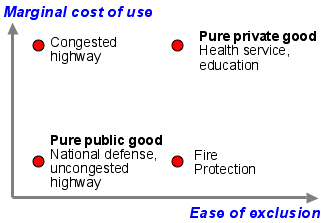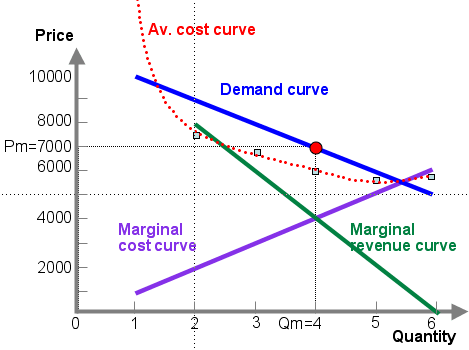 |
Economics - Imperfect Markets (1) |
Cat: ECO |
|---|---|---|
Jeseph E. Stiglitz and Carl E. Walsh |
09111u/18213r |
Title
Economics - Imperfect Markets
スティグリッツ経済学:不完全市場
Index
Tag
Externality; Public goods; Imperfect competition; Antitrust laws; Natural monopoly; FTC; Imperfect information; Free rider; Marginal revenue
Why?
-
It is essentially important to focus various themes particularly
related to features of economics in the information society.
-
The image and model of economics has changed
very much since typical classic books of economics written
in the age of stable growth economy.
- 情報社会の経済の特徴に特に関連するテーマに注目することは必須である。
- 経済学のイメージとモデルは、安定成長経済時代に書かれた典型的な古典経済学とは大きく変化してきている。
Summary
要約
>Top
0. Introduction:
- Adam Smith enunciated the view that markets ensure economic efficiency
200 years ago.
- Modern economics differ from that envisioned by the basic
competitive model.
- These difference can cause markets to operate inefficiently
- These differences can help account for the important role
that government plays in our economy.
- We obtain insights into many of the economic changes associated
with new technologies and the information revolution.
0. 序章:
- 200年前、アダムスミスは市場が経済効率を保証すると主張した。
- 現代経済学は基本的競争モデルの想定と異なっている。
- この相違によって市場は非効率になる。
- この相違によって、経済における政府の役割の重要性を説明できる。
- 多くの経済変革が新技術や情報革命に伴うものであること洞察できる。
>Top 1. Extending the basic competitive model:
- Extending the basic competitive model:
- Five key concepts in imperfect markets:
- trade-offs
- incentives
- exchange
- information
- distribution
- Key assumptions in the basic competitive model:
- Firms and individuals take market prices as given -
each is small relative to the market so that their decisions
do not affect the market price.
- Individuals and firms have perfect information about
the quality and availability of goods, and about the prices
of all goods.
- Actions by an individual or firm do not directly affect
other individuals or firms except through prices.
- Goods are things that only the buyer can enjoy. If I
buy and eat a slice of pizza, it is no longer available
for you to eat.
- Assumptions:
- Most markets are not as competitive as those envisioned by
the basic competitive model
- Buyers and sellers seldom have all the information that the
basic competitive model assumes.
- Firms and consumers bear all the consequences of their actions
in the basic competitive model. Whenever as individual or firm
can take an action that directly affects others but for which
it neither pays nor is paid compensation; externality is
present
- When one person consumes a good, it is not available for
others to consume in the basic competitive model. But some
goods, called public goods,
are available for others to consume. (extreme case of externalities.)
1.
基本的競争モデルの拡張:
- 基本的競争モデルの拡張:
- <不完全市場の5つの特徴>:
- トレードオフ
- インセンティブ
- 交換
- 情報
- 分配
- <基本的競争モデルにおける前提>:
- 会社も個人も市場価格は所与のものとし、各々は市場と比較して小さいので、それらの決定は市場価格に影響しない。
- 個人も企業も財の品質と入手および全ての財の価格についての完全な情報を持つ。
- 個人や会社の行動は、価格以外の方法では、他人や他社に直接影響を与えない。
- 財は買い手のみが享受できる。もし一枚のピザを購入して食せば、他人はそれを食べることができない。
- 前提:
- 多くの市場は基本的競争モデルが想定したように競争的ではない。
- 買い手と売り手は基本的競争モデルが想定したすべての情報を持つことはほとんどない。
- 基本的競争モデルでは、企業も消費者もすべての行動の結果に責任を持つ。個人や企業が他人に直接影響を与える行動をとっても、どちらも支払ったり支払われたりしない。外部性が存在する。
- 基本的競争モデルでは、一人が財を消費すれば他人はそれを消費できない。しかし、公共財という一部の財は他人も消費することができる。(外部性の極端な場合)
>Top
2. Imperfect competition
and market structure:
- Perfect competition:
- Many, many firms, each believing that nothing it does will
have any effect on the market price.
- Imperfect completion:
- Several firms, each aware that it sales depend on the price
it charges and possibly other action it takes, such as advertising.
- 1) Monopoly:
A single firm supplies the entire market. Your local electrical
company may have a monopoly in supplying electricity in your
area.
- 2) Oligopoly:
The automobile industry is an example, with three main producer
in US and a small number of foreign producers. Small number
of firms forces each to be concerned with how its rivals
will react to any action it takes.
- 3) Monopolistic competition:
An example is the market for laptop computers. Each is slightly
different from the others. But the laptops each makes are enough
to those supplied by the other companies that there is considerable
competition, so much so that profits may be driven down to zero.
- Price and quantity with imperfect competition:
- Marginal revenue:
In determining output, the firm will compare the extra, or marginal
revenue that it will receive from producing an extra unit
of output with the extra, or marginal cost of producing that
extra unit. If marginal revenue exceeds marginal cost, it
pays to expand output. Conversely, if marginal revenue is less
than marginal cost, it pays to reduce output.
- For a competitive firm, marginal revenue is just equal to the price.
- But with imperfect competition, a firm knows that the only way it call
sell more is to lower its price. Marginal revenue is not equal to the
present market price.
- To maximize profits, firms will set marginal cost equal to marginal
revenue. When competition is imperfect, marginal cost is also less than
price.
- Relative to the efficient outcome of perfect competition, imperfect
completion leads to a market outcome that results in too little being
produced at too high a price.
- Government policies:
- Antitrust laws: are designed to break up monopolies, to prevent
monopolies from forming, and to retain firms from engaging in
practices that restrict competition
- Natural monopoly: It may believe that is more efficient for
a single firm to provide the service. In the past as regulated
monopolies include local cable TV, electrical utility, and telephone
industries. The regulated monopoly firm normally must obtain
the approval of the regulatory agency before it can raise the
price it charges.
- FTC (The Federal Trade Commission): enforces consumer protection
and antitrust laws and plays an important role in eliminating
unfair or deceptive practices while ensuring that American markets
function competitively.
2.
不完全競争と市場構造:
- 完全競争:
- 多くの企業がいて、何をしようとも市場価格には影響しない。
- 不完全競争:
- 数社の企業があり、各々がつける価格や宣伝など他の行動に依存していることを認識している。
- 1) 独占:
例:地域の電力会社
1社がすべての市場に供給する。
- 2) 寡占:
例:自動車産業。
米国の場合、ビッグ3および少数の外国自動車メーカ。相互にライバル企業の行動に関心。
- 3) 独占的競争:
例:ラップトップPC市場。
相互に若干の相違があるものの、他社製品と似ているので、かなりの競争が行われ、利益はゼロに向かって縮小する。
- 不完全競争の場合の価格と数量:
- 生産量を決定する際に、企業は生産量をもう一単位増やすことで得られる追加収入(限界収入)を、もう一単位増やために追加費用
(限界費用)と比較する。限界収入が 限界費用を上回るならば、生産を拡大することで利益を増やすことができる。逆ならば、生産を縮小することが得になる。
- 競争企業にとっては限界収入は丁度価格に等しくなる。
- しかし不完全競争の場合は、企業はもっと多く売るための唯一の手段はその価格を下げることであることを知っている。
- 利益を最大化するには、企業は限界費用を限界収入に等しくせねばならない。不完全競争の時は、限界収入は価格を下回る。
- 完全競争では効率的な生産となるのに対し、不完全競争市場では市場での生産は価格が高すぎて生産量が過小となる。
- 政府の政策:
- 反トラスト法:独占企業を分割したり、独占の形成を防いだり、また企業が競争を制限することを行わせない。
- 自然独占:政府が1企業によるサービス提供が最も効率的と思える場合。過去に規制毒性とされた産業は、CATV、電力、電話事業などである。通常、規制独占はサービス価格を値上げする場合には政府の許可が必要。
- 連邦取引委員会(FTC):米国市場を競争的にし、消費者保護や反トラスト法を施行し、不公正な慣行や虚偽の誇大広告を排除する役割。
>Top 3. Imperfect information:
- Imperfect information:
- The information problem:
The basic competitive model assumes that households and firms
are well informed. This means that they know their opportunity
set, or what is available and at what price. More strikingly,
they know every characteristic of every good, including low
long it will last.
- Market for information:
Information has value: people are willing to pay for it. In this
sense, we can consider information is a good similar to any
other good. There is a market for information, with a price.
- However, even with all the new information technologies, the
market for information are far from perfect. The most conspicuous
one is that information is no just like any other good.
- After you were given the information, what inceptive
would you have to pay?
- There is a basic credibility problem. If a stock tipster really
knows that a stock's price is going to go up, why should he tell
me, even if I pay him for the information? Why doesn't he go
out and make his fortune with the information? Or is it that
he really is not sure, and would just as soon have me risk my
money rather than risk his?
- The information is still far from perfect. Some information
is simply too costly to obtain relative to the benefit of
having it.
3. 不完全情報:
- 不完全情報:
- 情報問題:
基本的競争モデルでは家計や企業は十分な情報を持っていることが前提となっている。即ち、何が入手可能でそれをいくらで購入するか、またそれがいつまで長持ちするかを知っているものとしている。
- 情報の市場:
情報には価値がある。人々は喜んで情報の対価を支払おうとする。この意味では情報は他の財と同じように考えられる。
- しかし、新しい情報技術を全て用いたとしても、情報市場は完全とは言い難い。はっきりしているのは情報は、他のどの財とも似ていないことである。
- 一旦情報を与えられると、誰もその情報を支払おうとするインセンティブがなくなる。
- 情報の信頼性の問題もある。もし株の予想屋が本当に株価が上昇することを知っていたら、たとえその情報代を支払ったとしてもなぜそれを教えるのか。なぜ予想屋自ら市場に参加してその情報で利益を得ようとしないのか、それともそれは確かな情報ではなく、彼の金の代わりに私の金をリスクにさらさせようとしているだけではないのか。
- 情報は依然として完成とはほど遠い。また一部の情報はそこから得られる便益に比べて単純に高すぎる場合もある。
>Top 4. Externalities:
- Externality:
- Even when there is perfect competition and information, the
market may supply too much of some goods and too little of others.
- Externalities arise whenever an individual or firm can take
an action that directly affects others without paying for a harmful
outcome or being paid for a beneficial one.
- Negative externality:
- Eg., air pollution.
- If the price consumers pay does not fully reflect the costs
of producing the good, consumers will demand too much of the
good and too much will be produced.
- Positive externality:
- Eg., rejuvenation of an apartment building.
- If there are social benefits in addition to the private benefits
to consumers, too little will be produced.
4. 外部性:
- 外部性:
- 競争や情報が完全である場合であっても、市場はある財を過剰に供給したり、過小に供給することがある。
- 個人や企業が、他の個人や企業に直接影響を及ぼすか、もたらした損害に対して支払わなかったり、与えた便益に対して支払いを受けないような行動を取るときはいつも外部性が生じる。
- 負の外部性:
- 例:大気汚染
- もし消費者が支払う価格が商品の生産コストを全額反映していなければ、消費者はその商品を過剰に需要し、そして過剰に生産されることになる。
- 正の外部性:
- 例:アパート建設の建て替
- もし消費者に対する私的便益に加えて社会的な便益もある場合は、過小にしか生産されない。
>Top 5. Public goods:
 Public
goods:
Public
goods:
The final category of market failure arises in the presence
of public goods. A pure public good is one where the marginal
costs of providing it to an additional person are strictly zero
and where it is impossible to exclude people from receiving
the good.
- the lower left corner represents a pure public good.
- the upper right corner represents a pure private good,
where the cost of exclusion is low and the marginal cost
of an additional individual using the good is high.
- nonrivalrous consumption:
the marginal cost of an additional individual enjoying he
good is zero
- Nonexcludability:
the cost of excluding an individual from enjoying the good
is prohibitively high.
- Free rider:
- it is difficult to preclude anyone from using them,
those who benefit from the goods have an incentive to
avoid paying for them.
- Eg: lighthouses, highways, parks, police, fire services
5.
公共財:
- 公共財:
市場の失敗の最後の分類は公共財が存在することに生じる。純粋の公共財は追加の一人に供給するための限界費用が厳格にゼロとなり、さらにその財を受領する人達を排除することが不可能な場合である。
- <左図> 左下の隅は純粋公共財を表す。
- 右上の隅は純粋な純粋私的財を表す。その財を排除するコストは低く、追加の個人にその財を提供する限界費用は高い場合である。
- 非競合的消費:
財に対する追加的な利用者の増加による限界費用がゼロの場合
- 非排除性:
財を享受することから個人を排除ための非容易が法外に高い場合。
- ただ乗り:
- 財を使用する人を排除することが難しい場合はその費用を支払いを避けるインセンティブが働く。
- 例:灯台、ハイウェイ、公園、警察、消防
>Top 6. Demand & marginal
revenue:
-
Eg: A case of a cement company:
-
sales
unit
Price
$
Total
revenue
Marginal
revenue
Total
cost
Marginal
cost
Ave.
cost
1
10,000
10,000
15,000
15000
2
9,000
18,000
8,000
17,000
2,000
7500
3
8,000
24,000
6,000
20,000
3,000
6666
4
7,000
28,000
4,000
24,000
4,000
6000
5
6,000
30,000
2,000
29,000
5,000
5800
6
5,000
30,000
0
35,000
6,000
5833
- The above table gives the demand curve facing a cement company,
which has a monopoly on the production of cent in its area.
As it lowers its price, it can sell more cement.

- At a price of $10,000 per unit, the firm sells 1 unit,
at a price of $9,000 it sells 2 units, and at a price of
$8,000, 3 units.
- The figure shows the demand and marginal revenue curves, using
the data from the above table.
- The output at which marginal revenue equal marginal
cost - the output chosen by the profit-maximizing monopolist
- is denoted by Qm. In our example Qm=4 units.
- At this
level of output, the price, Pm is $7,000 per unit, which
is considerably in excess of marginal cost $4,000.
- Total
revenues, $28,000, are also in excess of total costs,
$24,000.
6. 需要と限界収入:
- 左表は、ある地域のセメント生産を独占しているセメント会社の需要曲線を示す。
- 価格を下げれば、セメント販売を増やすことができる。
- いずれの場合でも限界収入は価格を下回る。
- 利潤極大化を目指す独占企業は、限界収入が限界費用と等しくなる産出量Qmを選ぶ。Qm=4単位
- 産出量を3単位から4単位に増やす時の限界収入は$4,000となり、限界費用に等しく成る。この時のPm=$7,000となる。これは$4,000という限界費用水準を上回る。
- また総収入は$28,000で、総費用$24,000を上回る。
- どのような産出水準でも、限界収入曲線 (緑色)は、需要曲線 (青色) の下側にくる。
Comment
- Economics in the information society should pay more attention
to the imperfect market.
- It is ironical that difference of useful information expands
among companies and individuals, though the cost of collecting
information relatively getting cheap and easy; probably because:
- it would be more difficult to select proper information among
so many garbage or pseudo information.
- It requares more analytical intelligence to utilize basic
information or data.
- One tends to disvalue or neglect information itself, on the
ground that the answer is prepared at commonly-avalable places.
- 情報社会における経済学は不完全市場にもっと注目すべきである。
- 情報を収集するコストが相対的に安くまた容易になっているにもかかわらず、役立つ情報の格差は、企業や個人間で広がっているのは皮肉である。その理由はおそらく
- 適切な情報を見出すのが、ゴミ情報や偽情報の中から選び出すことがより困難になっている。
- 基本的な情報やデータを活用するにはより分析的な知恵が必要である。
- 答えが手近な所に用意されているが故に、人は情報を軽視または無視しやすい。
Title |
Economics - Imperfect Markets |
スティグリッツ経済学:不完全市場 |
|---|---|---|
Index |
||
Tag |
Externality; Public goods; Imperfect competition; Antitrust laws; Natural monopoly; FTC; Imperfect information; Free rider; Marginal revenue |
|
Why? |
|
|
Summary |
要約 |
>Top 0. Introduction:
|
0. 序章:
|
>Top 1. Extending the basic competitive model:
|
1. 基本的競争モデルの拡張:
|
>Top 2. Imperfect competition and market structure:
|
2. 不完全競争と市場構造:
|
>Top 3. Imperfect information:
|
3. 不完全情報:
|
>Top 4. Externalities:
|
4. 外部性:
|
>Top 5. Public goods:
|
5. 公共財:
|
>Top 6. Demand & marginal revenue:
|
6. 需要と限界収入:
|
Comment |
|
|